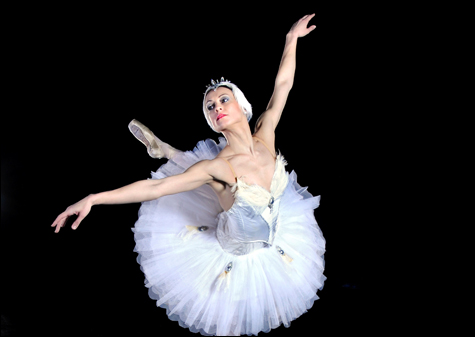
GRACEFUL: Vilia Putrius as Odette. |
Swan Lake is second only to The Nutcracker as a familiar entity for those with a nodding acquaintance of ballet. Both feature the lush and expressive sweep of Tchaikovsky’s music, with unmistakable and recurring themes; both have signature solos and pas de deux; both tell a grown-up fairy tale, complete with magical transformations. Festival Ballet Providence is going all out to cap its 30th anniversary season with its presentation of this classic ballet, at the VMA Arts & Cultural Center April 25 through 27.
“It’s the queen of all ballets, the most treasured and most adored,” emphasized artistic director Mihailo (“Misha”) Djuric, during a rehearsal break last weekend. “It’s extremely hard and has been a test for our com-pany.”
Djuric and ballet mistress Milica Bejelic have hued closely to the 1895 choreography by Marius Petipa for the second act, but they have set their own interpretation on the other three acts. Festival Ballet’s incarnation of Swan Lake also has a prologue — similar to the 2000 American Ballet Theatre version — that shows the princess Odette being turned into a swan by an evil sorcerer before the scene changes to Prince Siegfried’s birthday party at the palace.
This opening act is lively and playful, with the Prince’s mother trying to interest him in various princesses, his friends waltzing around him, a jester leaping everywhere, and a group of children circling sometimes ’round the jester and sometimes ’round the prince. The couples in the waltz have a light lift in which the female dancer is picked up on her partner’s right side, tilted slightly to his left and set down. That slight moment of off-kilter suspension grabs the eye.
As do the high-flying antics of the jester (played alternately by Henry Montilla and Ilya Burov). One leap has legs split front to back, the next split side to side and, in the next, the knees are pulled up with heels almost touching to form a diamond. In addition to the jester, the doddering old tutor, Wolfgang, played by Gianni Di Marco, provides considerable amusement in this scene — “the first act should have humor, just like Shakespeare,” Djuric noted.
In the second act, Siegfried takes his new crossbow to the lake to look for birds to shoot, but he recognizes that one of the swans is as much woman as bird. Siegfried pursues her through a phalanx of feather-laden dancers (a breathtaking corps de ballet of 16), and he pledges his eternal love to Odette, which is the only way the wizard’s spell can be broken. Vilia Putrius and Leticia Guerrero share the roles of Odette/Odile, Alexander Akulov and Davide Vittorino take turns as Prince Siegfried, and Eivar Martinez and Raeman Kilfoil portray the villainous sorcerer Von Rothbart.
Fluttering hand-movements, arms stretched out behind shoulders, hands bent at the wrist, hopping on one leg — all give swan-like suggestions to the dancers in the corps and the soloist as Odette. The latter must also accomplish the two dozen (or more) fouettés (whipping one leg around, rising on point on the other) of her alter ego Odile, introduced in the third act.
In that part of the story, Siegfried is tricked by Von Rothbart, who brings his daughter Odile to the palace. The prince believes her to be Odette and announces his engagement to her. Suddenly he realizes his mistake and rushes to the forest, where the swans are trying to console Odette. It is here that Festival Ballet breaks with tradition, not dooming the lovers to a double-leap into the lake but instead creating a happy ending.
“We wanted to leave the audience with a good note,” Djuric explained. “Otherwise, it’s too much trauma. Love always prevails and should prevail.”
The third act has some delightful sections a la Nutcracker (this was the first of Tchaikovsky’s three ballet scores), in which a Spanish flamenco, then a Neopolitan tarantella, and finally a Hungarian folk dance are invoked in the music and the movement.
Djuric is very pleased with the company’s execution of his dream to do this ballet: “Everyone grew up. There were a lot of emotions and acting to convey. It was a new experience for this company of new dancers, and all of them benefited from this work.”